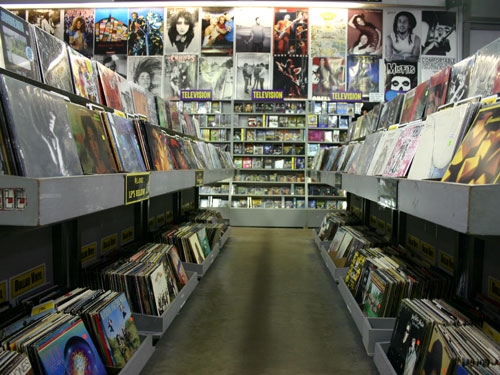
Vinyl records have become a hipster essential. (Picture from favim.com)

Have you been to a large urban record store lately? They don't look the same as they did a few years ago. Instead of thousands of different CD titles and perhaps a small section of used vinyl, now half of the floor space is devoted to new vinyl releases.
I don't have a problem with anyone selling or buying old records, it's the new records and reissues on vinyl that piss me off. What annoys me is that the vinyl fad is based on elitism and misinformation. Misinformation that has convinced far too many people to pay twice as much for a vinyl record than for the CD. That higher price for vinyl provides higher profit margins for sellers and incentivizes giving more space to vinyl in the stores.
This trend is not harmless. The popularity of vinyl is harmful to the cause of getting more good music to the masses, because it reduces opportunities for musicians to get their records into stores. The few remaining record stores now have half (or fewer) of the number of titles in their stores because new vinyl releases takes up so much space. This results in less variety and choice for consumers. I used to be able to find most of the titles I was seeking during a trip to a record store, now the odds of finding the title I want is slim. As a result, I have to buy online, taking the money out of our local economy and helping strengthen the bigger internet retailers. I am also concerned that in the long run the vinyl record fad will kill off what is left of the brick and mortar record business.

Vinyl records have become a hipster essential. (Picture from favim.com)

Charlie the Tuna desperately wanted Starkist to know that he had good taste
Digital recording is significantly more affordable and accessible for a much broader range of musicians. The combination of digital audio technology with the increased power of home computers has democratized music recording. In the past, an artist had to acquire a significant amount of funds or backing from a recording company to be able to access a recording studio and hire the required skilled technicians. Now almost anyone can record at home on their computer or even with their cell phone and burn and print professional appearing CDs and packaging at home.
The democraticization of recording does not mean that everyone is going to make a good recording, it still takes talent and skills. It is true that there is more bad music being recorded now than ever, but there is also much more good music. In particular, many more musicians who make experimental, niche or less commercial music are able to record and reach an audience. We would be getting more of the benefits of this glut of good music if radio stations didn't have such restricted playlists. The internet has helped make this music accessible but it takes motivation and an investment of time to find the good stuff.
Perhaps inevitably, this democratization of recording created a backlash. People seeking status do not want things that are accessible to the ignorant and lower income masses, they want things that are special and cost more.
I first noticed the analog trend in the recording magazine Tape Op several years ago. Perhaps to differentiate themselves from their competition, Tape Op largely featured hipster "indy" rock bands with a "retro" sound who chose to record on rare and expensive vintage analog equipment and largely ignored musicians who created music with low cost and efficient computer based digital recording systems. These hipster bands chose analog because it allowed them to record in the same manner as their heroes from the past and felt it gave their music a patina of credibility.
Not surprisingly, many manfucturers of audio recording equipment were happy to stop competing in the marketplace by selling increasingly affordable and powerful computer based products with slim profit margins. Now they can choose to sell expensive boutique-priced analog gear using older technology to affluent hipster musicians seeking status symbols instead. The vinyl fad is driven by the same desire for status symbols and is also a result of the misinformation spread by ignorant analog advocates seeking to show off their "good taste."

The misinformation is that vinyl/analog sound better than CDs. It is true that some vinyl records can sound better than some CDs under certain circumstances (virgin record, very high quality system). It is also true that CDs sound better than vinyl records in nearly all real-life situations. CDs and CD players are also less expensive, easier to use and store, can be portable and maintain their quality much longer.
The claim that vinyl is better simply because it is an analog format rather than digital is ridiculous because most new releases are recorded digitally. That means that those newly released high priced vinyl records clearly have less quality than the CD version since vinyl records have more noise, more wow and flutter and less dynamic range and frequency response limitations (in the lower frequencies) than CDs in addition to the puported deficiencies with the original digital recording.
CDs and digital recording developed a bad reputation among some people back in the early days of the technology. Unfortunately, legimate complaints about CD quality from 35 years ago are still influencing people today. In the 1980s the electronics of some digital equipment did not sound as good as high quality analog gear, especially with high frequency musical content. Most of these early problems have been addressed as the designs and components evolved over the last 35 years.
Adding to the confusion, in the early days of CDs many record companues would reissue older records on CD without making a sufficient effort to maximize the quality. In many cases they would not use the highest quality version of the original recording for creating the digital version. (Ironically, their earlier shoddy practices gave the labels an opportunity to re-sell improved remastered CDs years later.)
Although digital recording had numerous sonic advantages, for practical reasons the frequency response and dynamic range was limited on CDs. The limit on the higest frequency (pitch) was limited to 22Khz (22,000 cycles per second), well over the ability of anyone to hear.* It has been argued that even inaudible higher frequencies can impact how we perceive sound and there is some validity to that notion. However, listening tests have shown that most people do not perceive any difference when the frequency range is expanded on the high end.
Listening tests show that dynamic range,the amount of difference between the loudest and quietest sounds, is a much more significant limitation on the perceived sound quality of digitally recorded music than frequency response. That is why increasing the dynamic range has been adopted widely in studios and in the newer high quality digital formats such as DVD-Audio, SACD and Blu-Ray movies. Interestingly, at the same time as technology has made wider dynamic range possible, the trend in the record industry has been to limit dynamic range more than ever before. In fact, the limiting of dynamic range got so extreme a few years ago that consumers started to complain.
There were two reasons why the dynamic range was limited by record companies. One is that people tend to perceive music with a more limited dynamic range as louder and better. Radio programmers consistently pick louder sounding songs over those with more dynamic range because they want their stations to sound louder than the competition. However the consumer backlash of the early 2000s shows that there is a limit to that effect before the recording is simply perceived as harsh and lacking in variation.
The other reason for reducing dynamic range is because people often listen to the radio in noisy cars or work environments. Too much dynamic range can make the music inaudible during the quiet parts because the quiet parts can not be heard over the sounds in the environment. Excessive dynamic range is also problematic for people listening on the low quality ear phones that became more common when portable digital players became available.
Appreciating a wide dynamic range requires a quiet listening environment, a good system and the listener's willingness to tolerate the intrusion on the loud parts. Since relatively few people do that kind of listening, wider dynamic range, high quality audio formats such as DVD-Audio and SACD have not flourished for music use. High quality audio has been much more accepted for TV and movies because people are much more likely to devote their attention to media with a visual component.
CDs have a wider dynamic range than vinyl records and the surface noise of vinyl records further reduces the audibility of the lower volume sounds as the record degrades from repeated handling and playing. The technical limitations on dynamic range in CDs are irrelevant to the typical listening experience because the dynamic range is usually further reduced to accomodate radio programmers and those who listen in noisy environments.
Even the staunchest advocate of vinyl will concede that several factors need to be in place for a vinyl record to have an advantage over a CD. That is because playing vinyl records is a mechanical process with friction that degrades the vinyl. Playing a record involves dragging a diamond needle through the grooves of a plastic disc, which damages the record slightly with every play. (CD players use lasers which do not physically degrade the disc) That means that the sound quality of the record is reduced every time it is played. In addition, handling the record causes more physical damage (especially taking it into and out of its sleeve) and any dirt on the record's surface also reduces quality. Vinyl records often develop a static electric charge attracting dust to the surface.
The amount of surface noise on a record is also determined by the quality of the pressing, the number of times the record has been played, the quality of the phonograph needle (stylus), the cleanliness of the record's surface and how carefully it was handled and stored. Most of the time these factors result in vinyl records have far less dynamic range than CDs.
For optimum quality one needs a vinyl record that has not been played frequently that has been stored properly and cleaned before it is played. (of course the cleaning process is likely to damage the vinyl also) In addition, the needle (stylus) must be of good quality, in good condition and clean. The cartridge, which converts the motion of the needle to an electric signal must be of high quality and not too old. The turntable that spins the record needs to move smoothly and consistently and be isolated from any vibration in the room, otherwise someone walking heavily near the turntable may cause it to skip. The signal from the cartridge is very week and requires a good quality preamp for optimum quality. The sound system must be high quality overall to be able to perceive any differences at all.
To summarize, the vinyl advocate will tell you that vinyl is better, but only the first few times you play the record and only if you have expensive equipment, properly clean the record and the stylus every time it is played and consistently store the record properly. That is why vinyl is a medium suited for people with ample wealth and leisure time. Of course, these factors can be considered benefits rather than negatives by elitists or the type of people who enjoy the required cleaning and storage rituals.

Measurements do not reveal any advantage to vinyl but vinyl partisans will claim that there is a subjective difference. One can not argue with a subjective impression, but I raise these question for those who make this claim:
Are you sure that the reason you like vinyl better is not due to deficiencies in your sound system?
Are you hearing the recording more accurately with vinyl or does it just sound "nicer" to you?
If you think it sounds "nicer," could that be due to what you are accustomed to and/or because it evokes pleasant nostalgic associations?
When you choose to listen to a recent recording on vinyl, you are choosing to listen to an inaccurate version of the original recording rather than the sound that the artists intended for you to hear. If you prefer vinyl because it sounds "warmer" or otherwise "nicer" than the CD version it is because you like the noise and distortion added by vinyl.
Since "warmer" usually means "with reduced and/or slightly distorted high frequencies" the listener can often get the same results by simply turning down the treble control on their playback equipment.
Skilled record producers, audio recording technicians, musicians and mastering engineers know many ways to change the sound of an audio signal so that it is optimized for a particular musical context. We hear the results of their work whenever we hear a studio recording. Occassionally we might disagree with some of their choices, but generally most of us want to hear the finished product the way that they heard it and intended the listener to hear it. The CD of a recording is nearly always closer to the intended result than the vinyl version, especially when the record was made with digital equipment.
Unless you have a very good sound system, the issues you have with CDs may be due to the quality of your audio system. If you find that CDs sound harsh compared to vinyl records the first step is to check the settings on your system. Avoid extreme settings on your tone controls (bass and treble) which can cause distortion or harshness. The next solution you should consider is your speakers, which are the most important component in your sound system. An investment in better speakers is much more likely to improve your listening experience than switching from CDs to vinyl.
By the way, I agree with vinyl partisans about one thing: the packaging of vinyl records is much more attractive and the text easier to read. I wish they would sell CDs in larger sleeves so that the artwork and text is more easilly appreciated.
Packaging aside, CDs are a much better deal for 98% of all consumers, and filling stores with redundant vinyl releases of new records reduces the number of titles that a store can keep in stock. Fewer titles in stores means fewer opportunities for musicians to have their record noticed and purchased and fewer choices for consumers. That is why the vinyl fad is bad for musicians and listeners.
* "...The commonly stated range of human hearing is 20 Hz to 20 kHz.Under ideal laboratory conditions, humans can hear sound as low as 12 Hz and as high as 28 kHz, though the threshold increases sharply at 15 kHz in adults... Individual hearing range varies according to the general condition of a human's ears and nervous system. The range shrinks during life, usually beginning at around age of eight with the upper frequency limit being reduced...." (Dittmar, Tim (2011). Audio Engineering 101: A Beginner's Guide to Music Production. Taylor & Francis. p. 17. ISBN 9780240819150 and Moller, Aage R. (2006). Hearing: Anatomy, Physiology, and Disorders of the Auditory System (2 ed.). Academic Press. p. 217. ISBN 9780080463841. as cited by Wikipedia Wikipedia)
![]() Back to Oranj Productions Home
Page
Back to Oranj Productions Home
Page
Contact Info
All content Copyright 1993-2016 Oranj Productions.
All Rights Reserved. Commercial use, public distribution or presentation allowed with written permission only.